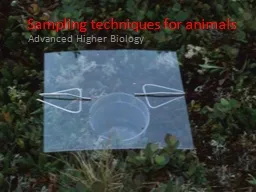PPT-Sampling techniques for animals
Author : tatyana-admore | Published Date : 2017-07-06
Advanced Higher Biology Capturemarkrelease techniques Lincoln Index Where n1 number of individuals initially caught marked and released n2 total number of
Presentation Embed Code
Download Presentation
Download Presentation The PPT/PDF document "Sampling techniques for animals" is the property of its rightful owner. Permission is granted to download and print the materials on this website for personal, non-commercial use only, and to display it on your personal computer provided you do not modify the materials and that you retain all copyright notices contained in the materials. By downloading content from our website, you accept the terms of this agreement.
Sampling techniques for animals: Transcript
Download Rules Of Document
"Sampling techniques for animals"The content belongs to its owner. You may download and print it for personal use, without modification, and keep all copyright notices. By downloading, you agree to these terms.
Related Documents














